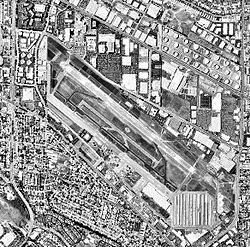Zamperini Field facts for kids
Quick facts for kids
Zamperini Field
Lomita Landing Strip |
|||||||||||||||
|---|---|---|---|---|---|---|---|---|---|---|---|---|---|---|---|

31 May 1994 USGS photo
|
|||||||||||||||
| Summary | |||||||||||||||
| Airport type | Public | ||||||||||||||
| Owner | City of Torrance | ||||||||||||||
| Location | Torrance, California | ||||||||||||||
| Elevation AMSL | 103 ft / 31 m | ||||||||||||||
| Coordinates | 33°48′12″N 118°20′23″W / 33.80333°N 118.33972°W | ||||||||||||||
| Website | [1] | ||||||||||||||
| Map | |||||||||||||||
| Runway | |||||||||||||||
|
|||||||||||||||
| [[Helipad|]] | |||||||||||||||
|
|||||||||||||||
| Statistics (2016) | |||||||||||||||
|
|||||||||||||||
|
Source: Federal Aviation Administration
|
|||||||||||||||
Zamperini Field (IATA: TOA, ICAO: KTOA, FAA LID: TOA) is a public airport located about three miles (5 km) southwest of downtown Torrance. Torrance is a city in Los Angeles County, California, United States.
The airport is important because it helps reduce air traffic at bigger airports. It was once called Torrance Municipal Airport. On December 7, 1946, it was renamed to honor Louis Zamperini. He was a local sports star and a hero from World War II. This date was also the fifth anniversary of the attack on Pearl Harbor.
Contents
History of Zamperini Field
The airport was finished by the United States Army Air Forces on March 31, 1943. It was first known as Lomita Flight Strip. It served as an emergency landing spot for military planes during training flights.
After World War II, the airport was closed. The War Assets Administration (WAA) gave it to the local government. Once the City of Torrance took over, they renamed it Zamperini Field on December 7, 1946.
What You'll Find at Zamperini Field
Zamperini Field covers about 506 acres (205 hectares) of land. It has two runways made of asphalt and concrete. The longer runway is 5,000 feet (1,524 meters) long. The shorter one is 3,000 feet (914 meters) long.
The airport also has one asphalt helipad. A helipad is a special area for helicopters to land and take off. This helipad is 110 feet (34 meters) long on each side.
In 2016, the airport had over 119,000 aircraft operations. An operation means a plane taking off or landing. Most of these (99%) were general aviation flights. General aviation includes private planes, not big airlines. About 276 aircraft are based at this airport. Most are single-engine planes.
The Airport Terminal
Zamperini Field has a small terminal building. Inside, you can find a vending machine for snacks and drinks. There is also a room for meetings and a bathroom. Pilots use a special room to plan their flights.
Outside the terminal, there is a patio with small tables. You can see historical papers about the airport on the walls inside. A Lockheed T-33 jet is on display outside the terminal. It's a cool plane to see!
Helicopter Landing Spot
There is a special helipad at the airport for a nearby hospital. This is the Torrance Memorial Medical Center. It's located at the northwest corner of the airfield. This helps with quick medical transport.
Airplane Manufacturing
Zamperini Field is home to the Robinson Helicopter Company. This company makes helicopters. Their entire factory, where they build and test helicopters, is on the southeast side of the airport. These are the largest buildings at the field.
The Western Museum of Flight
The Western Museum of Flight is now located at Zamperini Field. It used to be in Hawthorne, California. This museum is a great place to learn about airplanes and flight history.
Airport Incidents
Over the years, there have been a few incidents involving aircraft at or near Zamperini Field. Safety is always the top priority at airports.
- On April 9, 1982, a small plane had an incident shortly after taking off. It landed on a major street in Torrance.
- In 1986, a private plane from Torrance was involved in a mid-air collision. This happened with a larger plane heading to Los Angeles International Airport.
- On January 19, 2019, two small planes had a minor collision while moving on the ground at the airport. One pilot had minor injuries.
- On September 19, 2019, a plane crashed into a building about three-quarters of a mile east of the airport.
- On November 7, 2019, a plane that left Zamperini Field crashed into a home. This happened as it was nearing its destination in San Bernardino County.
- On February 19, 2021, a plane that took off from Zamperini Field crashed into a semi-truck. This happened on Terminal Island in the Port of Los Angeles.
See also
- California World War II Army Airfields






